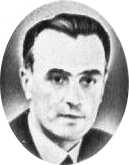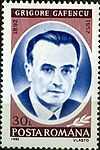Grigore Gafencu
| Grigore Gafencu | |
|---|---|
 | |
| Minister of Foreign Affairs of Romania | |
| In office February 1, 1939 – July 3, 1940 | |
| Monarch | Carol II of Romania |
| Preceded by | Nicolae Petrescu-Comnen |
| Succeeded by | Mihail Manoilescu |
| Personal details | |
| Born | January 30, 1892 Bucharest |
| Died | January 30, 1957 (aged 65) Paris |
Grigore Gafencu (Romanian pronunciation: [ɡriˈɡore ɡaˈfeŋku]; b. January 30, 1892, Bucharest - d. January 30, 1957, Paris) was a Romanian politician, diplomat and journalist.
Political career
Gafencu studied law and received his Ph.D. in law from the University of Bucharest. During World War I, he participated as a lieutenant and received the Mihai Viteazul Order for courage in battle. After the war, he became a journalist and founded the Timpul familiei newspaper, which was translated in French and distributed in many countries. At the age of 32, he became a National Peasants' Party deputy in the Romanian Chamber of Deputies (lower house of the Romanian Parliament) and was the assistant of the Minister of Foreign Affairs during the Iuliu Maniu government of 1928.
In 1938, he became a Minister of Foreign Affairs. For the next two years, he tried to assure the neutrality of Romania, which was caught up between Germany and the Soviet Union. Due to his efforts, he obtained guarantees from France and England, but those were not respected. After Northern Transylvania was annexed by Hungary as a result of the Vienna Diktat, and Bessarabia, Northern Bukovina and the Hertza region were annexed by the Soviet Union in 1940, he was sent as ambassador to Moscow. He returned to Romania after King Carol II named Ion Gigurtu foreign minister on 30 May 1940, and then left Romania to settle in Geneva, Switzerland.
Exile
During World War II, he collaborated with the Journal de Genève and other newspapers across Europe. In 1944, his book Préliminaires de la guerre à l'Est (Preliminaries of the War in the East) was published under the author name of Grégoire Gafenco at the Egloff publishing house in Fribourg.

After the war, Gafencu moved to Paris. He then published his second book, Last Days of Europe (Derniers jours de l'Europe, Egloff, Fribourg, 1946), in which he described his voyages across Europe in 1939 and 1940. In the preface he claimed that "the world made a war to kill influence zones and we must make a peace to kill them for a second time".
In 1947 he was invited by Yale University Press to the United States for a series of conferences; at that time, he lectured at New York University. He began to form groups that would militate for a European Movement, i.e., a federalization of the European states, in which Romania would also be included. He participated at the founding of the Free Europe Committee and he organized each Tuesday evening in his apartment on Park Avenue, New York City a series of meetings called Tuesday Panels in which current events were discussed.
He was a member of the Romanian National Committee (1949–1952) and was one of the founders of the Free Romanian League.
| |||||||||||
| |||||||||||||||||
|